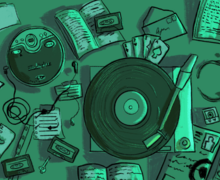Brewing coffee at home is a healthier option for the environment than going out for it
Meghan Hendricks | Photo Editor
Ditching your daily trip to Dunkin' Donuts or Starbucks will help save the environment and save you money and time.
Confronting my environmental waste problem has made me realize that my obligatory addiction to Dunkin’, prescribed by being a New Englander, is completely wrong. My coffee epiphany came after I evaluated my individual environmental footprint. I immediately stopped going out to buy a daily cup of coffee, however, I did not let my caffeine addiction waver. Instead, I developed a more sustainable and satisfying morning routine by brewing better coffee at home. By doing so, I’m saving the environment from my daily plastic-lined coffee cups, saving money and boosting my coffee-centered ego.
The waste created by disposable coffee cups is clear to anyone who goes to coffee shops. Coffee cups are used across the globe, and they can be found all around Syracuse University’s campus. It is hard to find a trash can on campus without a coffee cup sporting a signature Dunkin’ or Starbucks logo, and lectures frequently have at least one student sipping coffee from a disposable cup.
There is no shortage of disposable coffee cups on SU’s campus. But each cup takes an estimated 30 years to degrade in the environment.
Brands found on campus such as Starbucks and Dunkin’ both have waste reduction campaigns. Dunkin’ eliminated its use of polystyrene foam cups for hot beverages in 2020. Starbucks has marketed recyclable plastic cups with a strawless lid and commitments to reduce waste by 50% at their stores by 2050.
Both businesses allow reusable cups at their locations. However, it doesn’t seem like many people bring their reusable cup to campus cafes. Significant amounts of waste are still pushed out by consumers. This addiction to coffee served in plastic cups can be remedied if students and consumers are more conscious about what they drink and how they consume it.
Our addiction to buying coffee out is fueled by perceived convenience. However, going to the Dunkin’ at Schine means waiting in long lines, paying substantially more than the average at-home brew, and leaving personal preferences at the hands of others.
Brewing at home takes no more time than buying coffee somewhere else. As the name implies, leaving the comforts of home is not necessary when using the right equipment.
The process requires making simple, but conscious, choices. For example, the type of at-home coffee systems matters. Keurig coffee machines use a “K-Cup” system which refers to single-use plastic coffee ground holders. However, controlling the strength of coffee is difficult as grounds come pre-packaged in the K-Cup. Students can avoid this by looking for espresso machines or machines that allow the direct use of coffee grounds. Other parts of the brewing process that matter include choosing the correct type of coffee bean roast and how the beans are ground.
When I first switched to home-brewed coffee, the amount of places to go wrong seemed daunting. However, through trial-and-error, I managed to brew my perfect cup. If the brewing process is done properly, the coffee is substantially better than the average cup at Dunkin’ or Starbucks and requires no single-serve waste.
Our daily addiction to these cups must end with us consciously rejecting their usage. If Americans were more mindful of how they consume, waste problems in this country could be greatly improved. By opting for home-brewed coffee, students can simultaneously reduce their environmental burden and spending habits while increasing their ability to discern what good coffee truly is.
Harrison Vogt is a junior environment sustainability policy and communication and rhetorical studies dual major. His column appears biweekly. He can be reached at hevogt@syr.edu. He can be followed on Twitter at @VogtHarrison.
Published on February 9, 2022 at 10:19 pm






